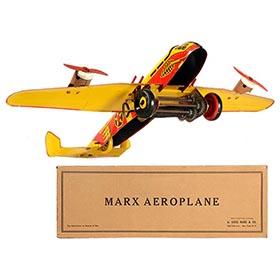1919 Wolverine, Sandy Andy Full Back (Football Player)Â in Original Box

Magnificent spring loaded mechanical Sandy Andy Full Back football kicker manufactured by Wolverine. Unarguably one of the rarest of all Wolverine toys ever produced it's in excellent+ to near mint condition and comes with its celluloid football. In addition the toy comes complete with its "legendary" original box plus instructions. In over 35+ years of collecting this is only the second complete example of this toy I've seen photographed, or in-person. The toy features a classic early 20th century football player in full uniform. The level of quality displayed by its design, artistry, and detail is amazing. The 6½" tall player stands with knees bent forward in a kick-off position. Left leg is stationary. Right leg is raised 1" above the green (grass) surface. An internal spring hidden inside the torso stretches from the back of the neck to the right hip. An axle running through the hip allows the right leg to raise and lower. The player stands on a tin platform which was lithoed to resemble a deep rich grained wood. In front and in back of the player are two crimson red tin litho fixtures. The front is called the trap. The rear is the trigger. Both are connected by a lever which runs the entire length of the toy. Pushing back on the trigger while raising the trap locks the lever underneath the base into position. After this, pulling back the right legs locks the right shoe sole onto a lip on the trigger thereby cocking the mechanism. The ball is placed sideways between the hands. Moving the arms, or just placing the ball into position allows it to drop through the hands, striking the trap, springing the trigger, and releasing the leg to kick the ball! The ball is a heavy celluloid with four grooved hemispheres and marked "Japan". The manufacturer's Japanese trademark appears on one side. The molded football laces are on the opposite side. It also has a small loop molded into one side. A long string could be tied through the loop and attached to the player. This would hopefully prevent losing it, but it still probably wouldn't last very long. Several years ago I sold an original advertisement for this toy which showed the looped football and string. However, the box and instructions show only a football without the loop. In addition, the only other example of the football that I saw also did not have a loop on it. It was also a darker brown. There is no indication other than my own experience that would indicate this is an original ball. In other words, it is a very old celluloid football, exactly the correct size and shape for the toy, but I have nothing to show that it's original. The toy was conceived as a game. One player becomes the kicker. The other players are receivers. The idea was to have it kicked in different directions randomly. Whoever caught the most balls within an allotted time was the winner. Great idea, but the delicate mechanism, forceful kicking potential and fragile celluloid football probably doomed it from the start. This accounts for the scarcity of the toy. The box is two parts with a separate removable lid. You can estimate the age of the toy just by looking at the cover illustration. It shows two boys, a young girl, and their mother (presumably). The boy operating the football player is the younger of the two boys. His sailor style clothing was popular for young lads. The older boy wears knickers with knee length stockings, tuck in shirt, and tie. The little girl is probably the youngest of the three. Mom wears very early post-WWI style clothing. Her short cut, banged hair was actually a "modern" post war design which continued into the early 1920's. A very complete list of directions, instructions, and even a schematic were printed on the underside of the cover. It suggests the different games you can play. At the very bottom it mentions that four more footballs could be purchased for 25¢. The box bottom was printed with the name of the toy and catalog number on all four sides. The longer panels include the manufacturer name and address. The short side panels also include an American Toys, Uncle Sam lithographed logo. This represented the "Good Housekeeping" seal of approval for its time. The box is incredibly rare for two reasons. First, because not many were manufactured or purchased. Second is due to the thin style cardboard that was used. Even though the bottom section had all four corners reinforced with metal supports, the weight of the toy plus its many points, corners, and raised metal surfaces would quickly destroy it. Size: 6¼" 4" x 8". Sold: Oct. 2006
Price Sold: $ 1641
















